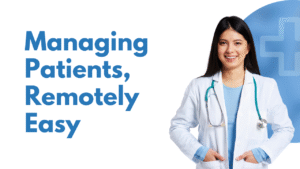The digital transformation of healthcare is accelerating, and telemedicine solutions are at the forefront of this change. By integrating telemedicine systems into hospitals, clinics, and private practices, providers can deliver faster, more accessible care to patients anytime and anywhere.
This blog explores how telemedicine in healthcare is expanding access to care, improving patient outcomes, and shaping the future of the healthcare industry.
What Are Telemedicine Solutions?
Telemedicine solutions refer to the technologies, platforms, and services that enable healthcare providers to deliver medical care remotely. These solutions include:
- Video consultations for primary and specialty care
- Secure messaging and virtual follow-ups
- Remote patient monitoring tools
- Electronic health record (EHR) integrations
- Mobile apps for appointment booking, prescriptions, and wellness tracking
By using a telemedicine system, providers can engage with patients in real-time, reducing the need for in-person visits and overcoming geographic barriers.
The Growing Role of Telemedicine in Healthcare
Telemedicine in healthcare is no longer a nice-to-have; it’s a vital part of modern care delivery. Here’s how it’s making a difference:
- Improved access: Patients in rural or underserved areas can now consult specialists without long commutes.
- Faster response times: Urgent concerns can be addressed virtually, preventing complications.
- Continuity of care: Regular virtual check-ins help manage chronic conditions like diabetes and hypertension.
- Cost savings: Reduces hospital admissions and lowers overhead costs for providers.
With a telemedicine system in place, providers can offer more flexible, patient-centered care while optimizing their workflow.
How Telemedicine Solutions Improve Patient Access?
Access to care is one of the biggest challenges in healthcare today. Telemedicine solutions address this by:
- Providing on-demand access to physicians and specialists
- Reducing appointment wait times
- Supporting after-hours care without extra staffing costs
- Enabling care for patients with mobility issues, childcare needs, or transportation barriers
For patients, it means fewer delays in receiving care and a more proactive approach to health management.
Key Features of an Effective Telemedicine System
Not all telemedicine systems are created equal. A high-quality solution should offer:
- User-friendly interfaces for both providers and patients
- Secure, HIPAA-compliant platforms
- Integration with EHRs for streamlined documentation
- Tools for video, audio, and chat communication
- Support for billing, scheduling, and reporting
Choosing the right telemedicine system ensures a seamless, efficient, and compliant experience for both patients and providers.
The Future of Telemedicine in Healthcare
Looking ahead, telemedicine in healthcare is expected to become even more sophisticated, with trends like:
- AI-driven diagnostic tools
- Expanded remote monitoring for chronic care
- Multilingual platforms for global patient populations
- Wearable integration for real-time health insights
These innovations will further reduce barriers to care and create more personalized healthcare experiences for patients worldwide.
Conclusion
Telemedicine solutions are transforming the healthcare landscape by improving access, enhancing efficiency, and enabling providers to deliver high-quality care across distances. As technology continues to evolve, telemedicine in healthcare will play a central role in ensuring that care is not just a place, it’s a service available to all, anywhere, anytime.
Interested in exploring telemedicine solutions that fit your organization’s needs?
Contact e-Health Network to learn how we can help you implement effective telehealth systems that enhance care delivery and patient access.






